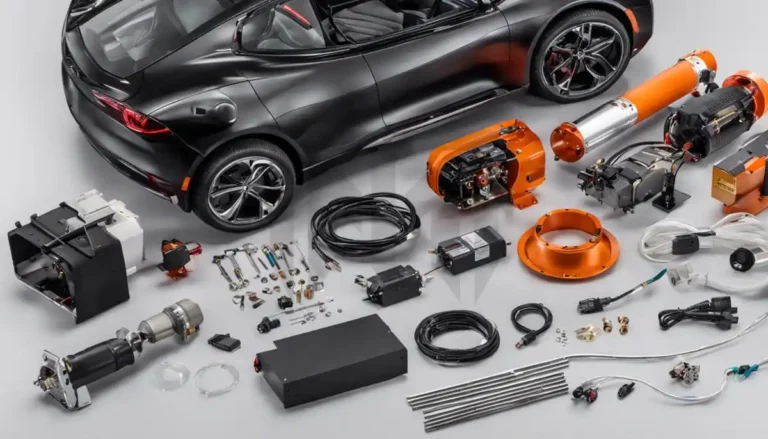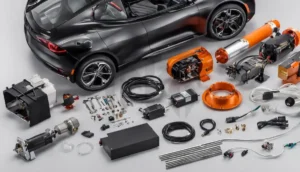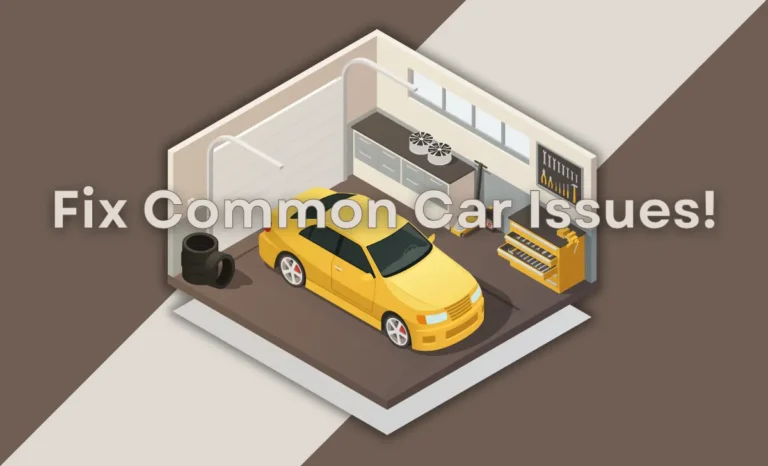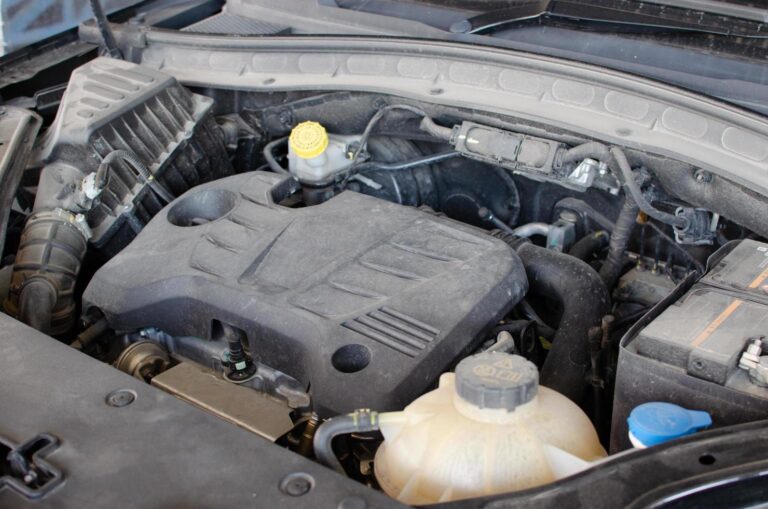
As vehicle technology evolves and environmental consciousness grows, more people are investigating the possibility of converting their traditional gasoline-powered cars to electric versions. Electric car conversion kits provide a practical solution for this transformation, allowing an existing vehicle to run on environmentally friendly electric power. This not only reduces carbon footprints but also offers improved efficiency and maintenance costs. The process, however, is not devoid of complexities. Understanding electric car conversion kits, how they work, and their potential benefits and drawbacks are crucial to making a well-informed decision. The legal considerations of conversions also cannot be overlooked, as compliance with regulations can vary from region to region.
In this article
- 1 In this article
- 2 Understanding Electric Car Conversion Kits
- 3 Converting a Gasoline Car to an Electric Car
- 3.1 Introduction to the Fundamentals of Car Electric Conversion Kits
- 3.2 Selecting the Right Electric Car Conversion Kit
- 3.3 Steps Involved in the Conversion Process
- 3.4 Importance of Understanding the Car’s Mechanical System
- 3.5 Maintenance Post Conversion
- 3.6 Legal and Insurance Considerations
- 3.7 Transitioning from a Gasoline to an Electric Car
- 4 Pros and Cons of Electric Car Conversion
- 5 Case Studies and Legalities of Electric Car Conversion
In this article
Understanding Electric Car Conversion Kits
Electric car conversion kits are retrofitting packages that enable a gasoline vehicle to run on electric power. The conversion process involves the replacement of an internal combustion engine with electric motor(s), batteries, and a controller. The purpose of an electric car conversion kit is to minimize fuel costs and reduce greenhouse gas emissions, serving as a versatile example of resource efficiency and environmental responsibility.
When you convert a conventional vehicle into an electric vehicle (EV), most, if not all, of the components linked with the gasoline powertrain are replaced or removed. This includes the engine, exhaust system, fuel tank, and cooling system. The engine is substituted with an electric motor, while the gasoline is replaced by batteries. The controller interconnects the batteries and motor, ensuring smooth and controlled driving by varying the motor’s speed and power.
The principal components used in electric car conversion kits are the electric motor, the power source (batteries), and the controller. Electric motors can be AC (Alternating Current) or DC (Direct Current), each with its set of pros and cons. Batteries store energy and can be made from different chemical compounds (like Lithium-ion, Sodium-ion, etc.), each tier having a different energy density, lifespan, and cost. The controller acts as the ‘brain’ of the electric vehicle, adjusting factors such as acceleration and braking.
The market offers two types of conversion kits – ‘Series’ and ‘Parallel’. In a ‘Series’ conversion, the internal combustion engine is completely removed, and the car runs solely on electrical power. A ‘Parallel’ conversion allows the vehicle to use both power sources (gasoline & electric), thus transitioning the car into a hybrid vehicle.
Changing your vehicle from its traditional power source to a more renewable and eco-friendly one involves the use of various conversion kits. The kit required depends on the make and model of your vehicle, and also on the type of conversion you’re aiming for – be it a hybrid, plug-in hybrid, or a battery electric vehicle (BEV).
Hybrid conversion kits modify your vehicle to allow for a combination of power from the electric motor and the traditional combustion engine, which can greatly decrease fuel consumption, especially during high-speed driving or acceleration.
Plug-in hybrid kits operate similarly to hybrid conversions, albeit with one major difference – they allow the motor to solely power the vehicle and can be charged from external electrical outlets, providing another level of convenience and eco-friendliness.
For those wanting to completely eliminate the use of gasoline, BEV conversion kits are ideal. They remove the internal combustion engine and replace it with an electric motor and a set of batteries, resulting in a vehicle that is 100% emission-free.
Regardless of the type of conversion kit you choose, it’s essential to remember that installing them requires professional knowledge of vehicle systems and electrical wiring. We highly suggest conducting extensive research and consulting with a professional before proceeding with any conversion.

Converting a Gasoline Car to an Electric Car
Introduction to the Fundamentals of Car Electric Conversion Kits
Undertaking the transformation of a petrol-powered vehicle into an electric one involves the use of an electric conversion kit. The primary components in these kits are an electric motor (which replaces the existing engine), a powerful controller to manage electricity flow, a set of batteries for energy storage, and a charging system. Aside from these, conversion kits also come with regenerative braking components, enabling your vehicle to generate electricity during braking.
Additional elements in the kit may include a battery management system, ensuring the safe and optimum use of the batteries. Furthermore, some kits may even provide solutions for controlling heating or air conditioning and power steering systems, which are traditionally powered by the gasoline engine in traditional cars.
Selecting the Right Electric Car Conversion Kit
To convert a gasoline car to an electric one, the first step is finding the right electric car conversion kit. There are plenty of options available, usually tailored to specific car models. Some kit manufacturers specialize in specific types of cars, like VW Beetles or classic Mustangs. The kit you choose will depend on several factors including your vehicle make and model, budget, and the level of customization you desire. Your personal mechanical skill level should also be taken into consideration; while some kits are geared toward beginners, others may require more advanced mechanical knowledge.
Steps Involved in the Conversion Process
Once you’ve selected a kit, the conversion process can begin. This usually starts with the removal of the engine, exhaust system, fuel tank, and any other components associated with the combustion drive train. Then, the components of your conversion kit are installed – starting with placing the motor in the engine bay. Batteries are typically placed in the trunk or under the hood, following which the controller and a DC-to-DC converter are installed. Finally, the charging system should be set up, the mechanics returned and the electrical system connected.
Check: Cars Battery Information for your car
Importance of Understanding the Car’s Mechanical System
The conversion process requires a deep understanding of a car’s mechanical system. While basic automotive maintenance and repair knowledge can help you install an electric car conversion kit, you also need to understand how to ensure the safe and efficient operation of the vehicle’s electrical and control systems. This typically involves conducting testing and debugging after the installation. Having a thorough understanding can help to identify potential issues with the conversion kit installation or other parts of the vehicle.
Maintenance Post Conversion
Maintenance of electric cars is different from gasoline cars, with fewer moving parts, but more electronics to manage. Post conversion, it becomes important to regularly monitor batteries and electrical components. Special attention should be given to battery health as overcharging or discharging can reduce their lifespan. Furthermore, the motor and its associated components should also be regularly maintained to avoid breakdowns.
Legal and Insurance Considerations
Before embarking on a conversion project, it’s essential to research local laws and regulations. In some jurisdictions, safety and emissions inspections may be required. Also, consult with your insurance provider to understand how conversion might affect your policy and premiums. Being informed in these areas can save you potential headaches later on.
Transitioning from a Gasoline to an Electric Car
Making the leap from a gasoline-powered car to an electric one, although challenging, can be an immensely rewarding task for auto enthusiasts with a firm grasp of vehicle mechanics. The project grants not only the liberty for personal customization but also the advantages of environmental preservation and economic efficiency associated with driving an electric car.

Pros and Cons of Electric Car Conversion
Investment in and Returns from Electric Car Conversion Kits
While an electric car conversion kit represents a substantial outlay, often exceeding $10,000 depending on your vehicle’s specifics and the selected kit, it’s crucial to weigh this initial investment against the potential long-term gains. Operating an electric vehicle typically proves more pocket-friendly than running petrol or diesel cars due to reduced fuel costs. Additionally, by converting to a greener vehicle, you could be eligible for governmental incentives intended to encourage environmental sustainability, thereby softening the initial financial blow.
Environmental Impact of Electric Car Conversion Kits
Transitioning your vehicle from running on traditional fuel to electric power through a conversion kit can have a significant positive impact on the environment. Electric cars have zero tailpipe emissions, reducing the emission of greenhouse gases and pollutants which contribute to global warming and poor air quality. Additionally, electric cars are often more energy efficient than those using traditional fuels, leading to less consumption of natural resources.
Performance Challenges and Improvements with Electric Car Conversion Kits
There can be mixed outcomes in relation to the performance of a converted electric car. Not every car is ideal for conversion, and some may experience decreased performance in terms of speed or power. On the other hand, electric cars are known for their fast acceleration and smooth handling, which can be seen as an upgrade in performance. Furthermore, the weight distribution in electric vehicles can be more even, resulting in improved stability.
Maintenance Requirements for Converted Electric Cars
Electric cars require less routine maintenance than their gasoline counterparts. Traditional vehicles often require oil changes, air filter replacements, and more frequent brake system repairs due to wear and tear as they age.
However, if something goes wrong in an electric car system, the issue could potentially be more complex and costly to fix. Battery longevity is another concern, with replacements needed anywhere from 5 to 15 years depending on model and use.
Availability of Qualified Technicians
Another factor to consider is the availability of qualified technicians to perform the conversion from traditional fuel to electric. While the number of qualified professionals is increasing, it is not always easy to find mechanic shops with experience in electric vehicle technology. As the technology continues to grow, however, access to professionals working with electric vehicle technologies will likely improve.
In essence, the decision to convert conventional cars into electric vehicles (EVs) requires a thorough understanding of both their benefits and drawbacks. In this fast-paced world of emergent technology, it’s important to stay updated as rules and technical specifications governing EVs are continuously evolving, greatly affecting aspects like your vehicle’s performance, upkeep needs, and much more.

Case Studies and Legalities of Electric Car Conversion
Practical Examples of Successful Electric Car Conversions
To illustrate the practicality of such conversion projects, there are numerous real-life examples. One particular story that stands out is of an individual named Matthew Quitter, who astoundingly managed to turn his vintage London taxi from the 1980s into an efficient EV, employing renewable energy components and an electric motor reclaimed from a forklift.
Similarly, Eric Hutchison from Electric GT saw potential in a damaged 1973 Ferrari, transforming it into a high-performing EV that surpassed the original model in terms of horsepower and torque. Hutchison’s project suggests that turning cherished, fuel-intensive classic cars into EVs—that are easier on the environment—could be the key to maintaining our rich automotive heritage.
The Legalities of Electric Car Conversions
The legalities of electric car conversion can vary greatly depending on geographical location and it’s crucial to know the regulations in your area before undertaking a conversion project. In the U.S, individual states have their own requirements. For instance, in California, an electric conversion must meet the emission standards of the year the car was originally produced.
In the UK, once you convert a car to electric, you need to re-register it with the DVLA. You also have to fill in a ‘V627/1 – Built up vehicle inspection report’ and pay vehicle tax. The car might be reclassified as a ‘rebuilt vehicle’ depending on the extent of the changes.
Certifications Needed for Electric Car Conversions
To ensure safety and compliance with the law, certifications may be required following the conversion of a conventional car to an EV. Certifications generally revolve around the electrical safety of the conversion and may involve inspections of the car to ensure it meets safety standards.
In the U.S., vehicle conversions must undergo a compliance review by the Environmental Protection Agency (EPA) to ensure they meet the Clean Air Act regulations. Compliance can be proven through testing or through an engineering evaluation.
In Australia, converted electric cars need to be certified by an engineer and meet specified safety standards, such as those outlined in the Australian Design Rules.
Ensuring Compliance and Safety in Electric Car Conversions
Ensuring compliance when converting a conventional car to an electric involves securing the relevant certifications, as previously mentioned, and strictly adhering to defined safety standards.
You should engage a qualified electrician to carry out inspections throughout the conversion process. Additionally, using Department of Transportation (DOT)-approved parts wherever possible can help to ensure compliance with safety standards.
By working closely with a mechanic who understands the inspection process, you will be able to avoid costly and time-consuming reworks. Investing in professional help upfront can ensure your converted EV is both legal and safe to drive on public roads.
Remember: each locality may have different regulations and it is beholden to the vehicle owner to comply with their regional laws relating to electric vehicle conversion.

Converting a gasoline vehicle into an electric one can seem daunting, but with the right information, tools, and guidelines, it becomes an achievable task. Electric car conversion kits are becoming more accessible and efficient, offering new opportunities for eco-conscious motorists. However, potential converters must not only understand the mechanics behind the process but also weigh the pros and cons to assess if this transformation suits their needs. While considering the significant environmental benefits and cost efficiency, the legalities tied to these conversions are equally important. Acknowledging all these factors ensures that the converted electric car not only contributes to sustainability but also provides a safe, legal, and reliable mode of transport.




